The sports world did not exactly come to a halt when I announced my retirement from marathoning in March 2016. I thought the New York Times or at least the Billings Gazette or the Jackson Clarion-Ledger would have sent a reporter to do an interview, get my thoughts on this epochal event and so forth—but nothing. When I put in a call to the Chosun Ilbo here in Seoul, they seemed to think it was a joke. Fine, I told them. See if I care! I was in very high dudgeon.
Of the 43 marathons I ran, nine of them were in Houston. The most populous city in Texas and the fourth most populous in the USA, it is a leader in energy, manufacturing, aeronautics, health care and 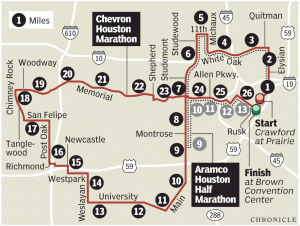 transportation with many Fortune 500 companies calling it home. Houston is a huge, sprawling city. Bear with me as I recollect as best I can the nine times I went 26.2 miles (42.195 kilometers) in H-town.
transportation with many Fortune 500 companies calling it home. Houston is a huge, sprawling city. Bear with me as I recollect as best I can the nine times I went 26.2 miles (42.195 kilometers) in H-town.
1987. This does not really count, but I drove down from Austin to watch a friend, Sebastian Villalva, run in the race. While I cannot remember how he did, the winners—Derrick May of South Africa and Bente Moe of Norway—are etched in my brain. On this day, I decided I had to do at least one marathon.
1989. I fulfilled that vow by running the Dallas White Rock Marathon in December 1988. My time of 2:48:02 encouraged me to try the Houston race four weeks later. In those days, I had a friendly rivalry with John Ferguson, and we agreed to run together as much as possible until the better man was proven. We kept up a steady 6-minute pace until about mile 12. Mother nature called, and she would not take no for an answer. I had to stop in one of the blue porta-potties along the race course and it was bye-bye, John. I then did something I came to regret; I impetuously made up my mind to catch him, that 2-minute deficit notwithstanding. John, meanwhile, was not exactly idling. He was on his way to a 2:39, the best he ever did in his long marathoning career. But I caught him! Around mile 20, I pulled up alongside. He was astonished, and I felt a little proud of what I had done. But I soon rued my decision. After no more than a mile of again going shoulder to shoulder with John, I had to slow down. I experienced for the first time the pain and drudgery of the late miles of a marathon. Stopping to catch my breath at every mile marker, I was losing precious time. Over and over this happened. The most memorable scene was around mile 25 in the very heart of downtown Houston. With gigantic skyscrapers on every corner, I was bent over in utter exhaustion. Next to me stood a Houston policeman. He asked me, “Are you OK?” In an effort to conserve energy, I just give him a one-syllable answer: “Yeah,” and plodded on to the finish line. Waiting for me there was John Collins, my long-ago UT friend. Despite all that going slow, walking and stopping, I managed a 2:44:33. Hindsight shows that this was my best chance to break 2:40. Had I run a reasonable pace after exiting the porta-potty, I could have gone five minutes faster. I would have been right there with John. But you know the old saying, “If ifs and buts were candies and nuts, we’d all have a merry Christmas.” Unfortunately, they’re not.
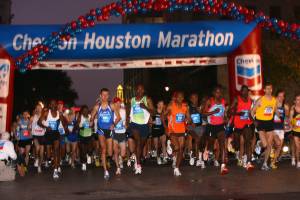 1991. In this, my seventh marathon, I had a cheering section of sorts. My GF, Kathleen Monte, had come with her son Brandon and his friend Nicholas. Somewhere around mile 23, Kathy and the boys saw me. They were in her Honda Accord, and she gave me a smile by turning up the sound on M.C. Hammer’s “U Can’t Touch This”—very popular in the early 1990s. My time was 2:48:12. Ho-hum, a 2:48:12. Big deal, right? In a few years, I would come to have far more respect for such performances.
1991. In this, my seventh marathon, I had a cheering section of sorts. My GF, Kathleen Monte, had come with her son Brandon and his friend Nicholas. Somewhere around mile 23, Kathy and the boys saw me. They were in her Honda Accord, and she gave me a smile by turning up the sound on M.C. Hammer’s “U Can’t Touch This”—very popular in the early 1990s. My time was 2:48:12. Ho-hum, a 2:48:12. Big deal, right? In a few years, I would come to have far more respect for such performances.
1993. I have only one memory of this race, in which I did a 2:45:54 (good enough for 60th place, my best ever in the Houston Marathon). I was among a pack of guys around the halfway mark. All of us were competent and fit, and we respected each other. We were conscious of running together and friendly, although we knew it was a cut-throat business; the buddy-buddy stuff would end sooner or later. If you couldn’t hang with us, you dropped back. Some did drop back, but we came upon others who took their place. On we went, mile after mile. When that pack finally broke up around mile 21, who do you think was left? Forgive me if it sounds like I am bloviating here, but candor trumps modesty.
1994. John (Collins, not Ferguson) lived in Houston and faithfully attended just about all of these races. I would see him at some point on the course and usually at the end. He always took photos of me at the finish line. In some, I looked exultant and in others I seemed to be at death’s door. I assume he watched the ’94 race, where I came across in 2:49:39.
1995. This was the first of five marathons (along with Austin, Boston, San Antonio and Dallas) I ran in 1995. I finished in 2:49:30. I cannot say for sure, but it may have been the time I saw John’s mother and daughter around mile 14. The little girl, named Lindsey, adored me. She had apparently convinced her grandmother to take her out on the course to watch me go by. As always in this January race, it was cold. The two of them were shivering but smiling as they waved to me.
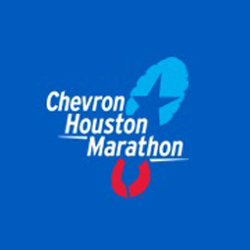 1996. The marathon, as my friend Jodi Welborn once told me, is a bear. It can bite you when you least expect it, she said. And by the same token, sometimes you do well for no particular reason. Such was the case for the ’96 Houston Marathon, which I ran in 2:44:42. This was one of the last of my really great races.
1996. The marathon, as my friend Jodi Welborn once told me, is a bear. It can bite you when you least expect it, she said. And by the same token, sometimes you do well for no particular reason. Such was the case for the ’96 Houston Marathon, which I ran in 2:44:42. This was one of the last of my really great races.
1997. The elements are part of running, and if you race often enough you are bound to encounter the whole gamut. I had run 5Ks and 10Ks in which the weather was atrocious (leaving aside numerous races in the hot Texas summer). I feared the day when I would have to endure such conditions in a marathon. Well, that happened in Houston in 1997. It was dark, it was cold, it was windy, and an icy rain was falling. Many people woke up that morning, said, “No, thanks” and got back in their warm beds. Just before 8 a.m., I was with several thousand people in the George Brown Convention Center, waiting and fretting. Some of them, I assure you, did not run in the race—the meteorological situation was that menacing. I would be a liar if I said I was not tempted to do just the same. But I knew I would have been unable to live with myself. About 2 minutes before the gun went off, I walked outside. I was wearing blue tights, a short-sleeve T-shirt and gloves. You should have seen how absurdly overdressed many others were. The whole thing was horrible. Keeping my balance on icy streets was hard, but don’t waste your pity on runners like me. The volunteers who served water, called out split times at every mile and did other mundane duties—God bless them! My time of 2:57:12 doesn’t seem so bad in light of the weather.
1998. I finished this race in 2:51:12 and walked into the aforementioned Brown Convention Center. I was getting a massage and chatting with a guy on the adjoining table. I asked him, “Are you planning to run in the Cowtown Marathon [six weeks later, in Fort Worth]?” He looked at me as though I were crazy. I got up, hobbled off and met a friend from Austin, Tommy Cornelison. He did not seem too embarrassed to admit that he had dropped out of the race. Tommy was like that. If things were not perfect, he had no qualms about quitting and trying again next time. I had a rather different view. Of the 700-plus races I have run, I have never quit. If I start, I will finish.
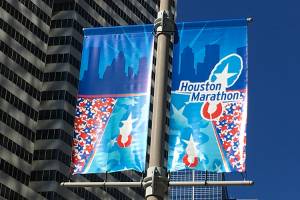 2004. This was my final time to run in the Houston race. I was coming off a three-year span (2000−2002) in which there were no marathons due to injury issues. I was older and less capable, and I could only muster a 3:03:39. Things had changed for the biggest marathon in Texas; the race organizers had given in to the temptation to add two-person and five-person relays. When I was writing my running column for the Austin AmStat in the late 1980s, I used to rage about these things. If you want to run a 10K or a half-marathon, go do it somewhere else, I wrote with some vehemence. “If you can’t go 26.2, you don’t belong out here” was my somewhat elitist attitude. I went inside the Brown Convention Center, picked up my medal, ate and drank quickly, and hardly bothered to chat with fellow runners. I found my car and returned to Austin.
2004. This was my final time to run in the Houston race. I was coming off a three-year span (2000−2002) in which there were no marathons due to injury issues. I was older and less capable, and I could only muster a 3:03:39. Things had changed for the biggest marathon in Texas; the race organizers had given in to the temptation to add two-person and five-person relays. When I was writing my running column for the Austin AmStat in the late 1980s, I used to rage about these things. If you want to run a 10K or a half-marathon, go do it somewhere else, I wrote with some vehemence. “If you can’t go 26.2, you don’t belong out here” was my somewhat elitist attitude. I went inside the Brown Convention Center, picked up my medal, ate and drank quickly, and hardly bothered to chat with fellow runners. I found my car and returned to Austin.

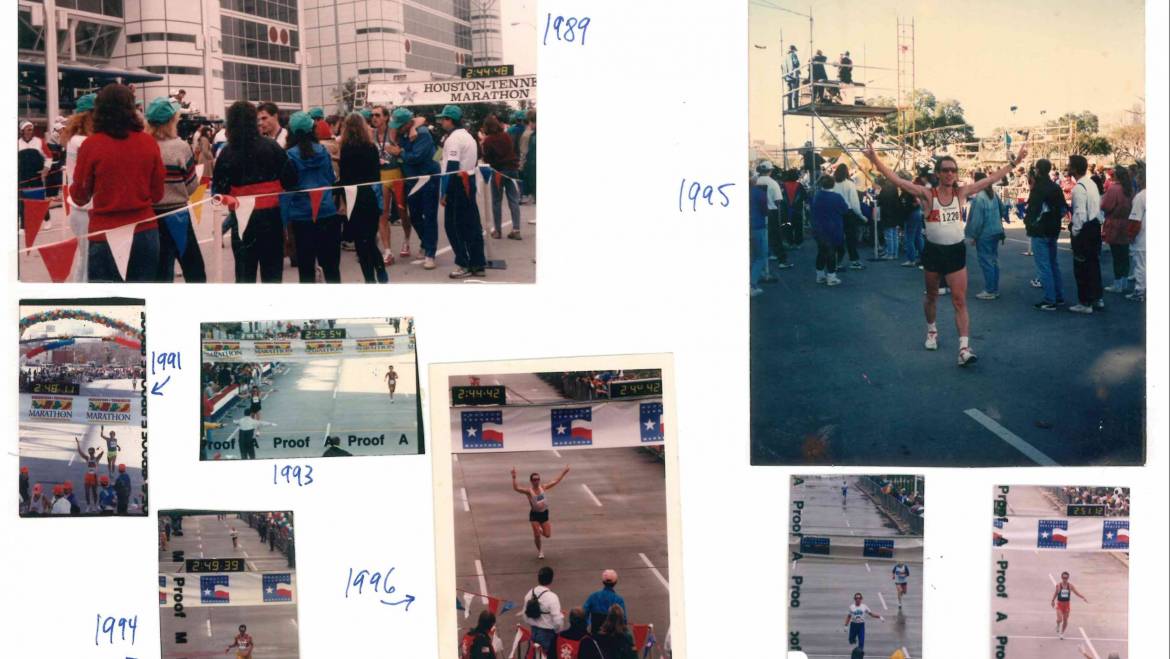
2 Comments
Intersting article, Richard! I did not realize you had run 43 marathons, that’s a stellar accomplishment. Having never run one, I cannot fully appreciate the discipline, athletic ability, and endurance needed to do so. The NYTs missed a great story!
Yes, but you won a varsity letter in high school–something I never did!
Add Comment